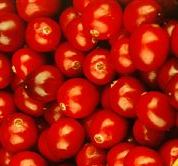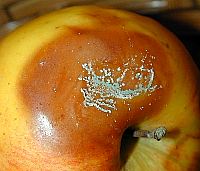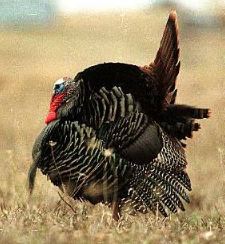Aspergillus
flavus, A. parasiticus |
Turkey-X Disease** **Turkey-X Disease deserves
a special mention. Aflatoxin was first discovered by observing a "plague"
that occurred on many turkey farms, particularly in England in the early
1960's, where the turkeys died rapidly and in great numbers. Since the causal
agent for the disease was not known, it was simply called "Turkey X disease."
Mycologists later discovered that the turkeys had been fed peanut meal
contaminated with Aspergillus flavus and related species. Although
aflatoxin is widely known for its carcinogenic properties, under the conditions
present at that time these fungi produced aflatoxin in such great quantities
as to rapidly kill the turkeys. This is no longer a problem since the peanut
meal, if used to feed the birds, is monitored very closely for the fungus.
There is no chance of turkey containing aflatoxin today. |
| Phytophthora infestans, cause of the Irish potato famine More than a million people died of starvation in Ireland in 1845-1846, and another million emigrated, mostly to the east coast of America. |
Late blight of potato
 |
| Synchytrium endobioticum |
Black wart of potato It's a Chytrid, a fungus with swimming spores. It mostly lives inside the host cells of the potato-hence the endobioticum. |
| Alternaria solani |
Early blight of potato and tomato Affects the fruits, stems and leaves, causing a wilt. Not surprisingly it occurs earlier in the growing season than late blight. |
| Rhizopus nigricans, Rhizopus tritici |
Soft Rot of sweet potato A post-harvest disease, usually exacerbated by poor storage conditions and poor curing (drying). Affected potatoes become soft and watery. |
| Monilinia oxycocci The main fungus responsible for cranberry crop loss in Wisconsin. Early infection causes crop loss. Infected fruits fail to ripen |
Cottonball disease/tip blight of cranberry |
| Bremia lactucae |
Downy mildew of lettuce A relative of Phytophthora, it causes lesions with geometrical margins on the lettuce, making it unattractive for sale. Severely affected leaves rot or dry out. |
Didymella bryoniae (sexual state) and Phoma cucurbitacearum (asexual state)

|
Black rot of pumpkin, a phase of the disease called gummy stem blight. Infected fruit may have black spots in the field and collapse soon after harvest from internal rotting. Doesn't that sound yummy? |
Claviceps purpurea |
Ergot contamination of cream and milk (through ingestion by the cow) The fungus contain the precursor to LSD and other secondary alkaloids, some of which cause gangrene. |
| Aspergillus
flavus, Aspergillus parasiticus |
Aflatoxin
contamination cream and milk Aflatoxin has been shown to be carcinogenic at 1 ppb (that's one part per billion). |
| Ustilago zeae-maydis Although considered a delicacy in Mexico, corn smut is responsible for billions of dollars in corn crop losses worldwide. |
Corn smut  |
| Colletotrichum lindemuthianum |
Bean anthracnose You've seen this one-- Green beans get horrible rotting black spots on them. |
Cryphonectria
parasitica  |
Chestnut
blight Chestnut blight, accidentally introduced into North America about 1904, has virtually wiped out the American chestnut in its native range in the eastern USA. |
| Puccinia graminis |
Black stem rust of wheat The main detrimental effect of the rust on food production is in the reduction of the amount of rolls & stuffing that are available. The fungus attacks the wheat and drains vital sugars from the plant, reducing the yield. |
Gibberella zeae/ Fusarium graminearum
 |
Head blight of wheat Besides drastically decreasing the yield of wheat, this fungus harms the crop in another way-- it produces two major mycotoxins, zearalenone and deoxynivalenol. |
| Erysiphe graminis |
Powdery mildew of cereal grasses Powdery mildews can cause significant loss of yields in cereal grasses and other types of crops. |
| Penicillium digitatum and
many other species The fungus rots the fruit and in many cases secretes mycotoxins into the food. |
Rot of apples and oranges  |
| Hemileia vastatrix |
Coffee rust
The rust cases premature defoliation of the plant, resulting in reduced yield and even death of the plant. Occasionally the unripe green berries are even infected. |
| Thielaviopsis parodoxa |
Pineapple disease of sugar cane. So called because the fungus attacks the growing parts of the sugar cane and rots them, causing the cane to smell like overripe pineapples. |
| Aphanomyces cochlioides |
Aphanomyces root rot of sugar beet. Attacks the large beet growing underground, often wilting the plant and causing death, or at least very low sugar yields. |
Trichoderma viride  |
Green mold disease of mushrooms. Trichoderma is a mold that can infect the mycelium and fruiting bodies of other fungi! |
Sclerotinia sclerotiorum |
Sclerotinia stem rot of Soybean, affecting Tofurkey production. This is a sliced tofurkey from Thanksgiving dinner 2000 in Oregon with Kelly Collins, Nancy Weber, Eric Hill and others. Yum! I can't think of anyone who wouldn't like stuffed vegetarian tofu turkey! |
 Mycology (the study of fungi) and Plant Pathology
(the study of plant diseases) can have a positive effect on everyone's
lives. For example, there are fungi that can infect just about every kind
of crop plant or animal, even those needed for Thanksgiving dinners. It
is one of the jobs of the mycologist or plant pathologist to control or
diminish the effects of fungi on these crops. The following list of fungi
affecting certain crops highlights some contributions of mycologists and
plant pathologists: None of these crops could be grown profitably and be
easily available for consumers for their Thanksgiving dinners without these
scientists' studies of the fungi and the crop plants. Some of these fungi
cause post-harvest diseases, and some infect the crops directly. Most of
these diseases are not a huge problem any more under prevailing conditions,
mostly due to studies of fungal life cycles and pathogenic properties by
mycologists and plant pathologists--- but there are always other diseases
waiting to take their place!
Mycology (the study of fungi) and Plant Pathology
(the study of plant diseases) can have a positive effect on everyone's
lives. For example, there are fungi that can infect just about every kind
of crop plant or animal, even those needed for Thanksgiving dinners. It
is one of the jobs of the mycologist or plant pathologist to control or
diminish the effects of fungi on these crops. The following list of fungi
affecting certain crops highlights some contributions of mycologists and
plant pathologists: None of these crops could be grown profitably and be
easily available for consumers for their Thanksgiving dinners without these
scientists' studies of the fungi and the crop plants. Some of these fungi
cause post-harvest diseases, and some infect the crops directly. Most of
these diseases are not a huge problem any more under prevailing conditions,
mostly due to studies of fungal life cycles and pathogenic properties by
mycologists and plant pathologists--- but there are always other diseases
waiting to take their place!












